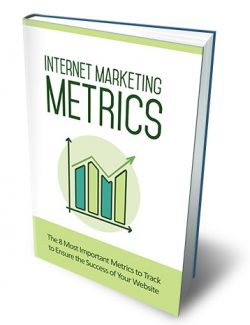 License Type: Master Resell Rights
License Type: Master Resell Rights  File Type: ZIP
File Type: ZIP
 SKU: 59495
SKU: 59495  Shipping: Online Download
Shipping: Online Download
Ebook Sample Content Preview:
Introduction
They say that ‘that which is measured, grows’. That is to say that the simple act of measuring some metric or other can be enough to help that metric improve. This is true for weight loss, where simply weighing yourself regularly can help the pounds fall off and of course it is true of digital marketing.
If you are not measuring the progress of your website or the growth, then there is no way for you to apply the scientific method to ensure that it continues on an upward trajectory. Without measuring, you have no way of knowing what’s working and what isn’t and you are essentially flying blind!
But measuring the success of a website is something that requires a certain science in itself. What precisely should you be measuring? What are the most important metrics? And how do these numbers work together to provide a detailed understanding of your traffic and your success? This guide will attempt to answer all those questions and more by focussing on the 8 most important metrics you need to be tracking!
1. Track Visits
The first thing to look at is the number of visits you are getting to your website. This metric in itself is not necessarily all that useful, seeing as it doesn’t necessarily provide much information regarding the type of person visiting your site, the way they’re engaging with your content or anything else.
What’s more, is that most websites will not see a visit as the ‘end goal’. If you are intending on building brand awareness, engagement and following, then you will need to reduce your bounce rate (see below). If you are trying to make money, then your ‘goal’ will be to increase your AdSense revenue, or to make more sales of your products. Visits in itself is really just an aside!
Despite this though, you need to know your visits in order to make sense of all the other data that you’re getting. You need to know your visits so that you can know what percentage of those visitors are buying from you and thereby calculate your conversion rate. Your visits tell you how many people you have to work with and they let you formulate a strategy on that basis.
And if your main income comes from AdSense impressions (rather than clicks), then there is a very good chance that your number of visits is going to correlate pretty much directly with your overall revenue.
When looking at this metric though, it’s important to recognize the subtle distinctions between the different kinds of ‘hits’ and ‘visits’.
For example, you have both ‘visits’ and ‘unique visits’. In many ways, the latter is actually more useful as this uses cookies stored on your visitors’ computers in order to identify repeat visitors. So if you have one mega fan who visits your website 20 times a day, then your ‘unique visits’ metric will help you to compensate for that and give you a more useful number that is a better reflection of your site’s popularity.
Another thing to consider is the difference between ‘hits’ and ‘visits’. Hits are different from visits because they actually represent every single demand placed on your servers. This means each new visit to your site but it also means image that gets downloaded and might also include ‘bots’ (scripts that work for search engines and other sites as a way of indexing the content on your site).
This means that if someone were to link directly to one of your images and embed it on your page (which isn’t the done thing but it does happen!), then you would see a massive increase in your hits that wouldn’t necessarily tell you anything about how many people were actually reading your content.
So at the very least, you should look at visits rather than hits. And most likely you are going to want to look at your unique visits more than that. And even then, this metric is going to be most useful when used in conjunction with others. Nevertheless, this is your starting point and it is the first metric you need to track. It is the broadest and most general descriptor of your overall success and is definitely a useful number to watch.
Note: This is a good time for us to point out that none of these metrics is infallible and it is certainly possible to ‘fool’ the reports. For example, if someone is using private browsing on their computer, then they won’t be storing cookies and that means that they may be counted as a new visitor (although normally the IP address is also taken into account). If a user has multiple computers more likely, then this too can also upset your statistics.
How to Increase Your Vusuts
So how do you go about increasing your page visits? The first thing you are doing correctly is monitoring them and seeing how they increase, as this way you can now try to make changes and see how your site improves or doesn’t. This will then let you know what’s working, what you need to change and more.
There are numerous different ways to increase page views and basically the answer here is: marketing. These days, that can include:
SEO
Social media marketing
Content marketing
Advertising
The key is to create a synergy between all these things and have a strong brand that drives through all of them. Content is very much the key as unless you’re a big, well-recognized online store, this is what is going to give people a reason to come to your website and it is what Google is going to be able to index and use to decide where you should appear on the SERPs (Search Engine Results Page). Content builds trust and engagement and encourages your visitors to share your site on social media and it gives you something of value to offer on social media too.
From there, you can also focus on building inbound links to your site from reputable and trusted domains, as well as using influencer marketing by teaming up with other brands and site owners to increase your exposure.
The last element – advertising – of course means spending money on a CPC (cost-per-click) ad campaign, a banner or perhaps a video ad. This will bring its own set of metrics, which is something we’ll be looking at more further into this post.
2. Bounce Rate
Your bounce rate tells you what proportion of your traffic lands on your site and then immediately leaves. This is a bounce and it basically means that although you have a visit, you aren’t engaging with that visitor and they aren’t stopping to read what you’ve created.
This is a good example of why visits don’t tell the whole story. If you have 1,000 daily visits with a 99% bounce rate, then that means that only 10 people are actually sticking around to read your site!
But bear in mind that a bounce rate still doesn’t tell the whole story. That’s because a bounce rate isn’t based on the amount of time they spend on your site but rather their interaction. So someone might bounce from your site after spending a while there – and this simply means that they didn’t click to read any of your other pages.
So even if you have a bounce rate at about 60%, that doesn’t necessarily mean that visitors aren’t reading your site – they may be reading the page but simply not feeling the need to read further. If your ‘site’ is a one page sales script, then this won’t necessarily be a bad thing!
A good bounce rate is generally thought to be anything from 26%-60% and you can consider anything under 30% to be very much in the ‘outstanding’ category. Being around 40% is very average and shouldn’t be a cause for concern. If you’re about 55%, then you’re getting into the higher portion but again, this is only a cause for concern depending on the type of site that you are running.
Finally, if you have a bounce rate over 70%, then that is considered poor/disappointing regardless of the nature of your website or blog.
As a general rule, your bounce rate is arguably more important than your visits because it tells you about engagement and what percentage of your traffic is likely to come back, is likely to buy from you and is likely to become a ‘fan’.
A similar metric to this is your ‘average time on site’. This is similar to a bounce rate but can potentially be even more brutal, as it tells you how many of your visitors visited your site, spent a few seconds on your page and then left immediately!
The average time on site metric is a very useful one for illustrating engagement too but as with bounce rates, it’s important not to get too worried if your metric doesn’t look good. The thing to remember is that 55% of visitors will spend fewer than 15 seconds on your website regardless of the content.
You could write an entire article about why this is. Suffice to say that as a species, we humans are becoming more impulsive and more impatient. We always feel busy, we always feel rushed for time and we rarely feel that we have the time to stop and smell the roses – let alone stop and read a website that we find generally interesting!
How to Shrink Your Bounce Rates
The question you really need to be asking yourself, is how you can get your bounce rates lower and your time on site higher.
There are many different factors that play a role here. One such factor is the design of your website and as in real life, first-impressions are incredibly important here! If someone visits your website and they feel that it isn’t particularly attractive or well designed, then this might be enough to cause them to immediately turn and leave!
The colors you use can have a big influence here and it’s worth looking into things like color psychology. For instance, did you know that the color red tends to make people leave faster? Blue and other ‘cool colors’ meanwhile have a calming effect and lead to visitors spending longer on a page as a result.








